| View previous topic :: View next topic |
| Author |
Message |
John S. White
Site Admin

Joined: 04 Sep 2006
Posts: 1298
Location: Stewartstown, Pennsylvania, USA



|
 Posted: Feb 26, 2010 09:46 Post subject: Golden kyanite Posted: Feb 26, 2010 09:46 Post subject: Golden kyanite |
|
|
For me one of the more interesting things to appear on the mineral market in recent years is the golden kyanite from Sangulungulu, Loliondo, Tanzania. The color is extraordinary, the pieces, although usually small, can be gem qualtiy and some have been faceted. Those that appeal to me most are the "V" twins as seen in this photograph. This piece is 4 cm across. Few are ever terminated, but that is typical for kyanite. This is also the locality for the spessartines of the same color which occur in fine large euhedral crystals showing the dominant trapezohedron, at times slightly modified by tiny octahedron faces.
| Description: |
|
| Viewed: |
38524 Time(s) |
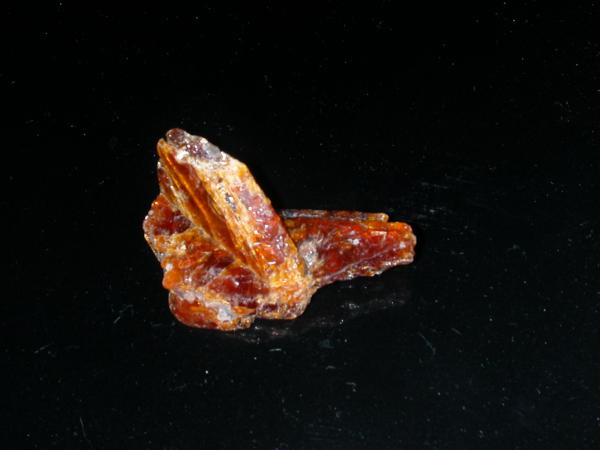
|
_________________
John S. White
aka Rondinaire |
|
| Back to top |
|
 |
robynahawk
Joined: 14 Mar 2008
Posts: 94
Location: Orange County, CA


|
 Posted: Feb 26, 2010 17:25 Post subject: Re: Golden kyanite Posted: Feb 26, 2010 17:25 Post subject: Re: Golden kyanite |
|
|
I have to agree John - there was a vendor selling it as Orange Kyanite at the Riverpark - it is definitely one of my favorites from Tucson!
Robyn
_________________
Find me at: facebook com/RockGemMineralClubs
facebook com/TucsonGemShow
Tucson at tucsongemshow.blogspot com
Home at flyviewsandreviews.blogspot com |
|
| Back to top |
|
 |
Pete Richards
Site Admin
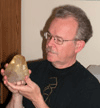
Joined: 29 Dec 2008
Posts: 846
Location: Northeast Ohio



|
 Posted: Feb 26, 2010 19:08 Post subject: Re: Golden kyanite Posted: Feb 26, 2010 19:08 Post subject: Re: Golden kyanite |
|
|
Very pretty specimen, John. But here's the comment that you might have anticipated from me: I don't see that this is obviously a twin. Perhaps it's a question of the photo. But how are the two parts of the twin oriented in the photo?
Has anyone determined the twinning relationship? Is it consistent from specimen to specimen? Dana's System vol. 8, with all its problems, does not list a twining relationship for kyanite that would produce v-shaped twins, it seems. Can you elaborate?
_________________
Collecting and studying crystals with interesting habits, twinning, and epitaxy |
|
| Back to top |
|
 |
John S. White
Site Admin

Joined: 04 Sep 2006
Posts: 1298
Location: Stewartstown, Pennsylvania, USA



|
 Posted: Feb 27, 2010 05:29 Post subject: Re: Golden kyanite Posted: Feb 27, 2010 05:29 Post subject: Re: Golden kyanite |
|
|
Well Pete you may have caught me making an unsupportable assertion. I have assumed twinning because this relationship is so common with this new kyanite. I have two examples myself that appear to have the identical angular relationship. The Handbook of Mineralogy describes lamellar twinning on {100}, twin axis normal to {100} or parallel to [010] or [001], common, but I doubt that this would produce the butterfly relationship we see here. The fact that these "butterfly" twins appear quite common makes me want to believe that there is yet another twin law for kyanite heretofore unrecognized. Why not?
_________________
John S. White
aka Rondinaire |
|
| Back to top |
|
 |
Pete Richards
Site Admin

Joined: 29 Dec 2008
Posts: 846
Location: Northeast Ohio



|
 Posted: Feb 27, 2010 10:47 Post subject: Re: Golden kyanite Posted: Feb 27, 2010 10:47 Post subject: Re: Golden kyanite |
|
|
It's entirely possible that these kyanite crystals display a previously unrecognized twin law. The fact that there are many examples with the same apparent angle helps make the case for twinning. I have not seen any of these personally, so I can't say that I'm convinced they're NOT twins, but as John points out, the twinning described in the texts would not seem to lead to such a morphology. I'll hope to see some examples at the Rochester Mineralogical Symposium.
_________________
Collecting and studying crystals with interesting habits, twinning, and epitaxy |
|
| Back to top |
|
 |
Luiz Menezes
Joined: 10 Dec 2009
Posts: 140
Location: Belo Horizonte


|
 Posted: Feb 27, 2010 13:35 Post subject: Re: Golden kyanite Posted: Feb 27, 2010 13:35 Post subject: Re: Golden kyanite |
|
|
Hi John and Pete:
I think these "V"-shaped clusters of golden kyanite crystals from Tanzania are twins; I bought several of these crystals at the Riverpark from Werner Radl (Mawingu Gems, probably the same dealer that Robyn has mentioned), and the angles look consistent. My specimens are in my office and I will only be able to photograph them on Monady, I will try to put 2 of them side by side to try to demonstrate that they show the same angle.
Confirming John's information that they came from the same locality for the nice orange spessartine crystals that have been recently offered to the market, I am annexing below a photo of a nice specimen that I bought at the 2009 Mineralientage München from Werner Radl.
Regards
Luiz
| Description: |
| Spessartine crystal, 1.5 cm, on the top of a Golden Kyanite, 5 cm - Loliondo, Tanzania |
|
| Viewed: |
38337 Time(s) |
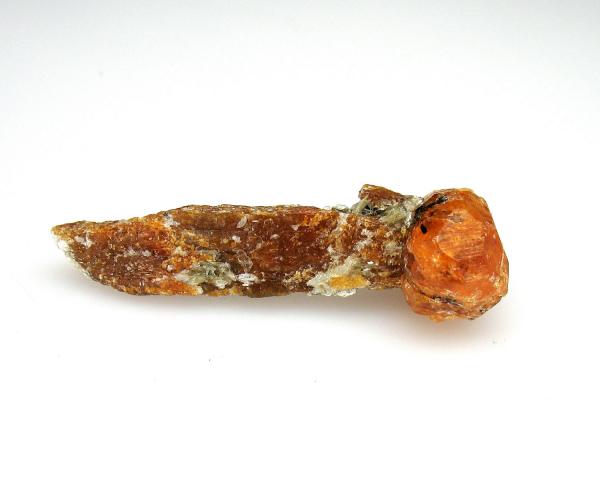
|
|
|
| Back to top |
|
 |
John S. White
Site Admin

Joined: 04 Sep 2006
Posts: 1298
Location: Stewartstown, Pennsylvania, USA



|
 Posted: Feb 28, 2010 06:25 Post subject: Re: Golden kyanite Posted: Feb 28, 2010 06:25 Post subject: Re: Golden kyanite |
|
|
A really wonderful specimen Luiz. It certainly answers the question about whether or not the two minerals occur at exactly the same place.
_________________
John S. White
aka Rondinaire |
|
| Back to top |
|
 |
Jim Prentiss
Joined: 01 Dec 2009
Posts: 103
Location: Ohio



|
 Posted: Mar 13, 2010 15:21 Post subject: Re: Golden kyanite Posted: Mar 13, 2010 15:21 Post subject: Re: Golden kyanite |
|
|
Hello Gentlemen,
Just today, at a semi-local gem and mineral show, I became acquainted with the orange Kyanite. It is not sepecially pretty but it is translucent with a nice amber-gold color in transmitted light. That said, where might I find more information on the occurrence in Tanzania.
Thank you,
Jim Prentiss
|
|
| Back to top |
|
 |
John S. White
Site Admin

Joined: 04 Sep 2006
Posts: 1298
Location: Stewartstown, Pennsylvania, USA



|
 Posted: Mar 14, 2010 10:26 Post subject: Re: Golden kyanite Posted: Mar 14, 2010 10:26 Post subject: Re: Golden kyanite |
|
|
The following was found on mindat.org:
A new locality for fine spessartine garnets. Located about 35 km NE of Loliondo proper "in the middle of nowhere." A village called Lemisikio is nearby.
"This deposit was visited and studied by Mr. Jochen O. Hintze, German geologist. He described it as an approximate 100 meter wide quartz mass or vein with weathered detritus. The quartz is criss-crossed with veinlets of hematite. The spessartine garnets are bound to the hematite in the veinlets. Most work to date has been digging into the loose weathered material to retrieve the garnet crystals. Only a little work has been done on the intact quartz mass. (priv. comm. J. Hintze to C. Lemanski, Tucson, 2008)."
The place name is new and was assigned by the local Massai tribesmen. The spelling was graciously provided by Mr. Hintze from his field notebook. The locality (new village) is growing rapidly with the arrival of new residents responding to the "Garnet Rush."
References:
Lapis (2008): 33(7-8).
_________________
John S. White
aka Rondinaire |
|
| Back to top |
|
 |
Gerhard Niklasch
Joined: 27 Mar 2009
Posts: 134
Location: Munich



|
 Posted: Mar 30, 2010 15:38 Post subject: Re: Golden kyanite Posted: Mar 30, 2010 15:38 Post subject: Re: Golden kyanite |
|
|
I got this stone on the cheap at a recent auction---- oops, wrong thread! ;)
Ok, kidding aside: Just after this present thread took off, I serendipitously discovered that such an orange presumed-twin Kyanite was being offered on auction by a very respectable vendor (Marcus Oglieri). My curiosity was piqued, and I won it at a very reasonable price. It's now in my collection as 10TZK-001.
Over the course of the last couple of weeks, I've attempted to figure out the hypothetical twinning law, and I'm going to report on my findings in this post and the next.
But first another reference:
Karan M Chadwick and George R Rossman, Orange kyanite from Tanzania, Gems & Gemology (2009) 45#2, 146-147. The abstract is available online at
http:(slash)(slash)minerals(dot)caltech(dot)edu(slash)Manuscripts(slash)2009(slash)Orange_Kyanite(slash)Index(dot)html
The color is attributed to Mn^3+.
The little two-winged beauty is just 20mm tall and about 14mm wide, so all of the following photos were taken through the stereo microscope. All the stereo pairs are crossed-eyes. (If you prefer parallel viewing, you can use your browser's 'Save image as...' function to download and save the image, and use your favorite image manipulation software to cut it in halves and stick them back together the other way round.)
| Description: |
Here's looking onto the left wing with back lighting,
field of view 15.7x19.1mm. |
|
| Viewed: |
37842 Time(s) |
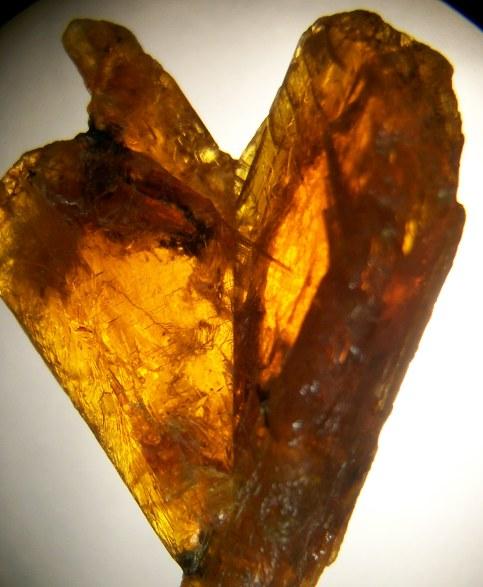
|
| Description: |
The same in stereo with the right wing sticking out,
FOV 15.7x18.6mm. |
|
| Viewed: |
37836 Time(s) |
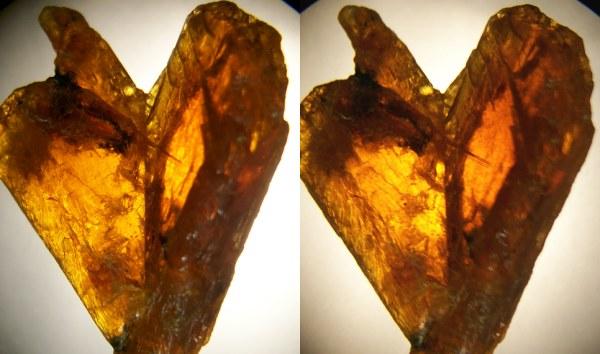
|
| Description: |
Now the right wing is lying flat and the left wing is sticking out.
FOV 12x18mm. |
|
| Viewed: |
37810 Time(s) |
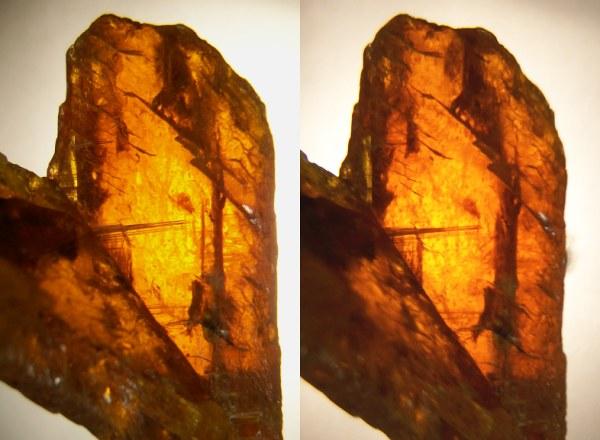
|
| Description: |
Looking down along the hinge line from the top of the V.
FOV 13.2x14.7mm. |
|
| Viewed: |
37848 Time(s) |
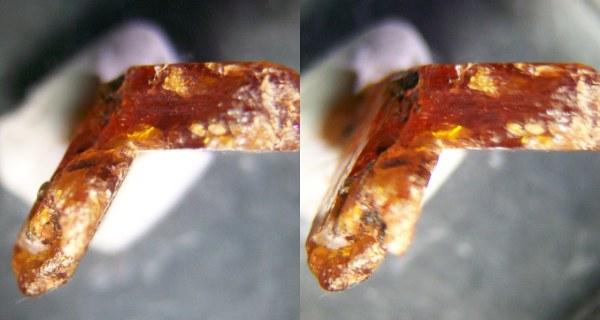
|
| Description: |
And looking at the foot end of the V, formed by a pointy extension of the right wing.
FOV 11.7x16.4mm. |
|
| Viewed: |
37823 Time(s) |
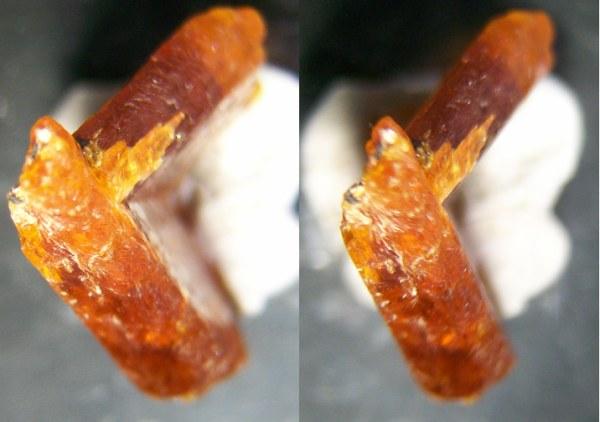
|
| Description: |
Let's rack up the magnification for a closer look at how the two wings meet. The hinge line seen from inside the open angle between the wings is the straightest feature of the whole specimen - it's clearly crystallographically controlled.
In this view, the left wing is mostly reflecting the blueish light of the fill-in LED, highlighting the uneven surface texture (which was giving me a lot of trouble with my measurement attempts).
FOV 6.2x9.1mm. |
|
| Viewed: |
37843 Time(s) |
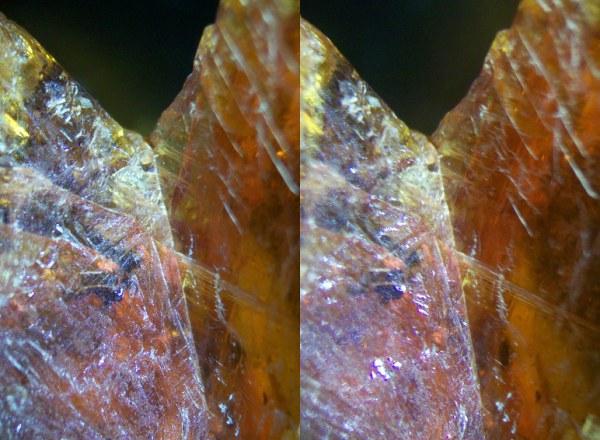
|
| Description: |
The concave angle where the two wings meet seems to have favored extra growth at a late stage, more yellow than orange.
FOV 5.7x7.8mm. |
|
| Viewed: |
37876 Time(s) |
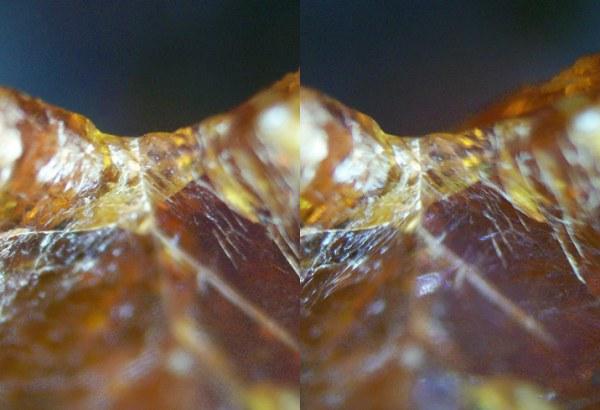
|
| Description: |
Crossing the saddle and looking at the outside of the angle, we see the trace of the composition plane petering out. The left wing -- on the right in this view -- has grown a bit across the plane over onto the right wing's side. The extra material again is a lighter shade of yellow, suggesting that this was a relatively late addition to the crystal.
FOV 9.2x11.8mm. |
|
| Viewed: |
37883 Time(s) |
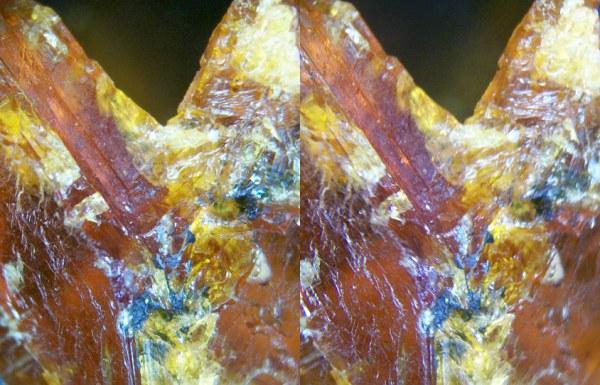
|
|
|
| Back to top |
|
 |
Gerhard Niklasch
Joined: 27 Mar 2009
Posts: 134
Location: Munich



|
 Posted: Mar 30, 2010 15:45 Post subject: Re: Golden kyanite Posted: Mar 30, 2010 15:45 Post subject: Re: Golden kyanite |
|
|
I thought it would be a very simple exercise the establish the opening angle between the two wings, but my investigations were severely hampered by the uneven surfaces. The best I can say with confidence is that the angle is between 117° and 123°!
I tried a variety of methods:
* Simply looking down along the hinge line onto a sheet of paper and drawing the projection,
* taking photographs viewing along the hinge line and measuring the projected angle in the images,
* jerry-rigging a horizontal single-circle goniometer out of an old theodolite, with a white LED a few meters away as the signal, and with the crystal placed on the alidade with the hinge line upright,
* and finally, using several of the prism angles of two solid apatite crystals for comparison, holding the kyanite wings against the prism faces and wiggling them for best contact whilst viewing along the edge with one eye.
The results in each case were reasonably repeatable and reasonably in agreement with each other, but there are simply too many shallow hillocks and smaller-scale roughness on the inner faces of the wings to pin down the angle better than to +-3°.
But fortunately, the opening angle isn't the only parameter we can read off!
| Description: |
Let's look again onto the inner face of the right wing (FOV 12x18mm). Guided by typical Kyanite habits, we expect this to be a (100) face, and we expect the wing to be extended along its c[001] axis. (I've also considered the possibility that this might be a (010) face, but this didn't lead to a plausible solution in the end.)
The precise direction of the c axis isn't particularly easy to identify in this picture, but the hinge line forms an angle of about 35° with it. Using the known axis ratios and angles for Kyanite, this is consistent with the hinge line being either [012] or [0 1 -2]. (The angle alpha between b[010] and c[001] is almost exactly a right one for Kyanite, which simplifies the calculations, but which results in this ambiguity: it is not possible to pin down the signs of the second and third indices by measuring angles in the (100) plane alone.)
The hypothetical twinning/composition plane must contain the hinge line, thus its indices must be of the form (+-h +2l -l) or (+-h +2l +l). |
|
| Viewed: |
37816 Time(s) |
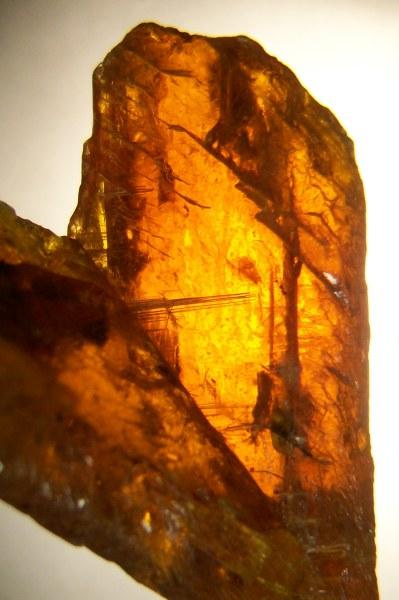
|
| Description: |
A truly lucky feature of this specimen is that (100) isn't the only lateral pinacoid that's recognizably developed. Looking along the c[001] axis of the right wing (FOV 15x15mm), we can see (0 -1 0) and (1 -1 0), too! This fixes the orientation of the b[010] axis and narrows down the possibilities for a[100]. We don't yet know whether the latter is inclined upward or downward. (At any rate, it appears foreshortened in this view, and between b[010] and the projection of a[100] we see an apparent angle which is larger than the true angle gamma.)
This observation determines one more sign: The composition plane must have indices (+h +2l -l) or (+h +2l +l). |
|
| Viewed: |
37808 Time(s) |
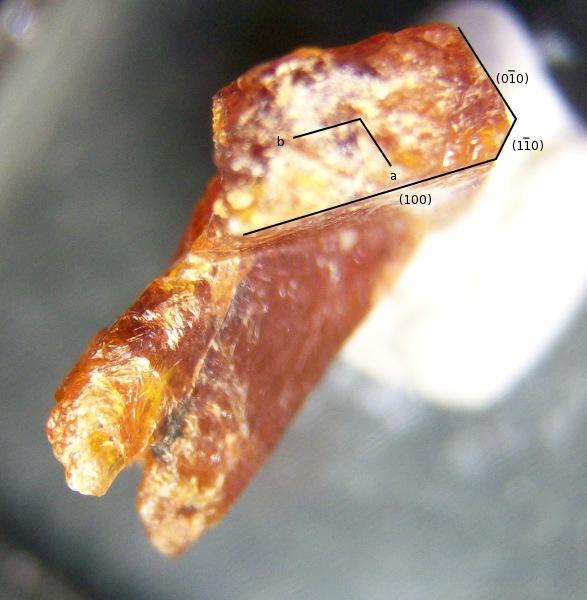
|
| Description: |
| The left wing (FOV 15.4x17.5mm) also shows the additional pinacoids, in an arrangement which is a mirror image of the right wing's. |
|
| Viewed: |
37812 Time(s) |
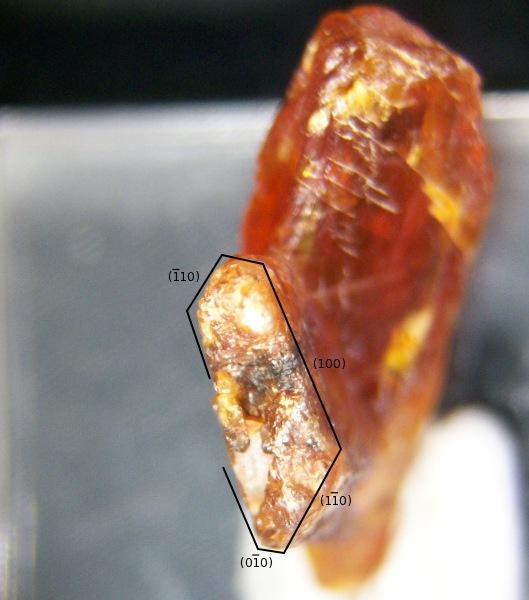
|
| Description: |
Armed with the above and with our approximate knowledge of the opening angle of 120°+-3°, seen here looking down onto the V almost parallel to the hinge line (FOV 14.5x15.3mm), we can finally put forth a plausible hypothesis: Unless the indices are improbably large, the one possibility for the twinning plane is (1 2 -1), which would result in a calculated angle of almost exactly 59° against (100), and thus in an opening angle between the (100) faces of the two wings of almost exactly 118°.
(I've spent a while staring at the crystal models on the webmineral page for Kyanite, trying to see how to cut up the lattice and reattach it to a mirror image of itself along various possible planes. It doesn't look too convincing to me. But perhaps the real, lattice-level twinning operation is a glide reflection rather than a reflection.) |
|
| Viewed: |
37834 Time(s) |
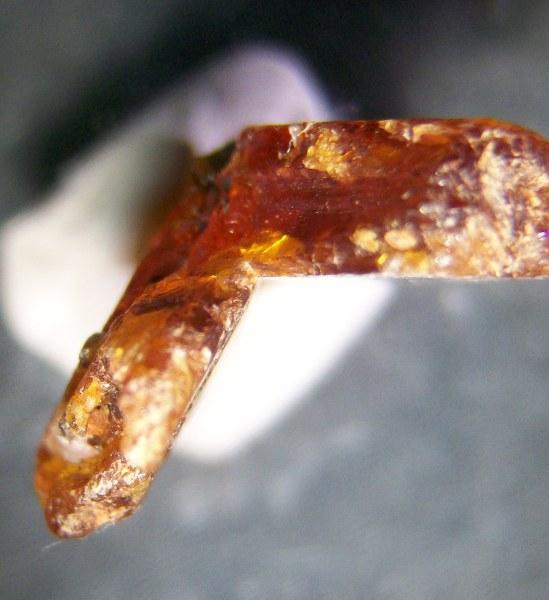
|
|
|
| Back to top |
|
 |
Gerhard Niklasch
Joined: 27 Mar 2009
Posts: 134
Location: Munich



|
 Posted: Mar 30, 2010 16:11 Post subject: Re: Golden kyanite Posted: Mar 30, 2010 16:11 Post subject: Re: Golden kyanite |
|
|
Whoops. For all prior proofreading, now I see that I've misspelt Marcus Origlieri two posts up. My apologies!
Pleading DST lag...
Cheers, Gerhard
|
|
| Back to top |
|
 |
John S. White
Site Admin

Joined: 04 Sep 2006
Posts: 1298
Location: Stewartstown, Pennsylvania, USA



|
 Posted: Mar 31, 2010 04:29 Post subject: Re: Golden kyanite Posted: Mar 31, 2010 04:29 Post subject: Re: Golden kyanite |
|
|
Excellent work Gerhard. Perhaps now we can convince Peter Richards that these pairings are indeed twins and stimulate him to work on them himself. As mentioned, I have two examples that I will let him examine and Carl Francis reports that Harvard University has a "twin" in blue kyanite that shows the same relationship, and he will also lend this to Pete.
_________________
John S. White
aka Rondinaire |
|
| Back to top |
|
 |
Pete Richards
Site Admin

Joined: 29 Dec 2008
Posts: 846
Location: Northeast Ohio



|
 Posted: Mar 31, 2010 08:13 Post subject: Re: Golden kyanite Posted: Mar 31, 2010 08:13 Post subject: Re: Golden kyanite |
|
|
This is a very nice analysis! I will look forward to doing some measurements on my optical goniometer to confirm that the twin law is {12-1}. Working with just the previously posted photos and trial and error using SHAPE, I came up with {121} as a tentative twin law. This gives angles close to those produced by {12-1}, but the difference should be easily detected when some specimens are in hand!
_________________
Collecting and studying crystals with interesting habits, twinning, and epitaxy |
|
| Back to top |
|
 |
Elise

Joined: 22 Dec 2009
Posts: 243
Location: New York State



|
 Posted: Apr 22, 2012 11:45 Post subject: Re: Golden kyanite Posted: Apr 22, 2012 11:45 Post subject: Re: Golden kyanite |
|
|
I was very happy to see a continuation of this discussion in greater detail in the latest Rock's & Minerals magazine "A Re-discovered Twin Law in Kyanite from Africa"
by R. Peter Richards, John S. White and Peter B. Leavens Vol. 87, No. 2 March/April 2012
http:(slash slash)www.rocksandminerals(dot)org/Back%20Issues(slash)2012/March-April%202012(slash)twin-law-abstract(dot)html
It inspired me to dig out my treasures from the last Tucson trip (still haven't unpacked). On the last day I ran across this specimen marked down from $40 to $5 and was happy to add it to my study collection. It is not quite as transparent as the one in Gerhard's photos above, but it has wonderful inclusions of several types. The red crystals are the most interesting -- they seem to be isotropic and many are angular and are reminiscent of a euhedral garnet - these are perhaps spessartine given the locality, but it is very hard to tell (rutile has also been reported). It was difficult to manipulate the whole specimen under crossed polars and observe the inclusions' reaction at the same time, that is why I am unsure of their nature (slightest trembling of fingers made the inclusion jump in and out of the field of view). It would be easier to just snap that thin section of the right blade off and play with it under the microscope - I'm just kidding, it is a great little specimen paired with this thread and the R&M article! I'll just have to stop drinking coffee and steady my hands to figure those red crystals out!
This is what makes FMF fun!
Best wishes,
Elise
| Description: |
Kyanite
Loliondo, Arusha Region, Tanzania
Red inclusions contained in the thinner area of the top of the right "wing" (as seen under 60x magnification) |
|
| Viewed: |
34660 Time(s) |
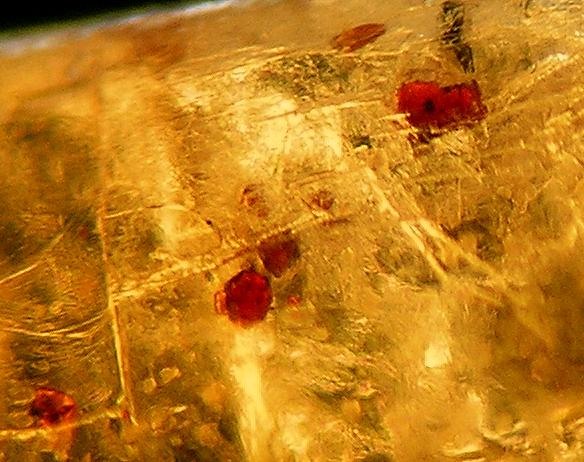
|
| Description: |
Kyanite, twinned
Loliondo, Arusha Region, Tanzania
23 x 15 mm
Swarms of red crystals can be seen as dark spots, especially in the lower part of the left wing in the orientation seen in the image. |
|
| Viewed: |
34641 Time(s) |
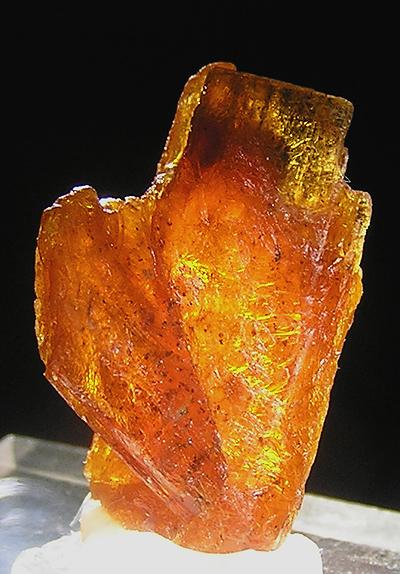
|
|
|
| Back to top |
|
 |
|




